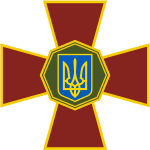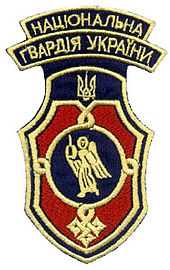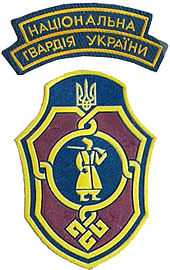National Guard of Ukraine
| National Guard of Ukraine Національна гвардія України | |
|---|---|
 | |
| Active |
4 November 1991 – 11 January 2000 (8 years, 2 months) 13 March 2014[1] – present (1 year, 1 month) |
| Country |
|
| Allegiance | Government of Ukraine |
| Branch | Law enforcement |
| Role | Reserve force / counter-insurgency |
| Part of | Ministry of Internal Affairs |
| Motto | "Honor, Courage, Law" |
| March |
(Current incarnation) National Anthem Shche ne vmerla Ukraina |
| Anniversaries | 26 March[2] |
| Engagements |
1992–94 Crimean crisis[3] Transnistrian conflict (border security reinforcement Spring/Summer 1992) 2014 Crimean Crisis 2014 pro-Russian conflict in Ukraine |
| Commanders | |
| Current commander | Stepan Poltorak[1][4] |
| Insignia | |
| Ensign |
 |
The National Guard of Ukraine (NGU; Ukrainian: Національна гвардія України, Natsionalna hvardiya Ukrayiny) — is the reserve component of the Armed Forces of Ukraine under the jurisdiction of the Ministry of Internal Affairs that was revived in 2014 based on the Internal Troops of Ukraine. The Guard would then be reestablished on March 13, 2014 amidst rising tensions in Ukraine and its region caused by the military intervention in Crimea by Russia.[5]
The National Guard was originally created on November 4, 1991 right after Ukraine gained its independence under a direct supervision of the Supreme Council of Ukraine. However it was controversially disbanded nine years later on January 11, 2000 as part of a 'cost-saving' exercise by the then President Leonid Kuchma. In 1995 - 2000 there existed both the National Guard of Ukraine and the Internal Troops of Ukraine.
History
The National Guard was recreated in accordance with the Law of Ukraine "On the National Guard of Ukraine" [Law number 4393] dated March 12, 2014,[6] (the draft legislation being originally introduced to the Ukrainian parliament on March 11). A previous attempt by then President Yushchenko to bring back the National Guard during civil unrest in 2008 had been blocked in the Rada. It was finally re-established in March 2014 after the beginning of the Crimean crisis.[7]
The NSU was originally created by the Law of Ukraine "On the National Guard of Ukraine " dated November 4, 1991 № 1775 -XII. Dissolved by the Law of Ukraine "On Amendments and Additions to Certain Legislative Acts of Ukraine " dated 11 January 2000. During its early existence, the National Guard was indirectly involved in the Transnistrian conflict during the Spring/Summer of 1992, helping to defend the border against a threatened spill-over of the conflict into Ukraine. Formations involved were the 3rd, 4th and 5th divisions NSU (equipment transferred from the 93rd Motorized Rifle Division was also used in this deployment). Afterwards, up until 1998, National Guard units backed up the border guards in anti-smuggling operations conducted on the border with Moldova and Moldova's breakaway Transnistria region.
Reformation
In 2014 the reformed force was to be created partially on the basis of the Internal Troops of Ukraine, with plans for militias and armed wings from certain of Ukraine's political parties and organisations, including the Euromaidan movement, to be also incorporated into it. However those plans have run into resistance from at least some of the latter, who do not wish to give up their weapons or otherwise subordinate themselves to government control.[8] Direct recruitment from military academies is also intended.[9] On March 16, the Yatsenyuk Government announced plans for the recruitment of 10,000 people within the next 15 days for the National Guard.[10] Individual volunteers are also being accepted.
The 2014 law provides for an initial authorised strength of 33,000 personnel. It also tasks the National Guard with maintaining public order, protecting sites like nuclear power plants and “upholding the constitutional order and restoring the activity of state bodies”,[11] in part a reference to the situation in Crimea, as well as to the perceived Russian threat to Ukraine as a whole. In the eastern parts of the country in particular, not only will the National Guard reinforce regular military units defending against a feared Russian invasion, it will also be expected to uphold Part 1 of Art. 109 of the Criminal Code of Ukraine [lower-alpha 1] (i.e. it is intended to act as a counterinsurgency force against 'fifth columnists' and infiltrators).
The National Guard will be receiving a large proportion of the money from the emergency budgetary reprogramming approved by parliament for the funding of weapons procurement, equipment repair, and training (said reprogramming is equivalent to $600 million in 2014 Dollars).[12] Eventually it is hoped that the strength of the National Guard will rise to 60,000 personnel. The pay for National Guard regulars is approximately 214 Euros ($297) a month, equivalent to an average Ukrainian's monthly income. Officers receive about twice that amount.[8] There are also some attached Internal Troops personnel, mostly for training and/or logistical support purposes, e.g. K-9 teams that have been taking part in training and demonstration sessions.
Structure

Current
- Main administration
- Territorial commands
- Units of direct subordinance
- Educational institutions
Pre-2000
At the end of 1992, six divisions were formed:
- 1st (Kiev) Division - Kyiv, Zhytomyr
- 2nd (East) Division - Kharkiv, Chuhuiv, Luhansk
- 3rd (South) Division - Odessa, Kharkiv, Simferopol, Sevastopol, Mykolaiv, Kherson
- 4th (North) Division - Donetsk, Dnipropetrovsk, Mariupol, Pavlohrad, Kryvyi Rih
- 5th (West) Division - Lviv, Lutsk, Ivano-Frankivsk, Ternopil, Drohobych
- 6th Division - Chuhuiv (formed from the 48th Motor Rifle Division and became the 92nd Mechanized Brigade in 1999)
- 7th (Crimean) Division - Simferopol (from 1996 - formed from 126th Motor Rifle Division)
Other elements included, at various times:
- Academy of the Internal Troops[lower-alpha 2]
- School for senior NCO (Kharkiv)
- Training Brigade - Zolochiv, Lviv region[14]
- Training Regiment - Donetsk
- Novorossiysk-Kiev Separate Guards Regiment (Presidential Guard unit[11])[15][lower-alpha 3]
- 22nd Separate Guards brigade for the protection of foreign embassies - Kyiv (Kiev)
- Logistics Regiment - Kyiv.
- Aviation Management NSU[lower-alpha 4]
- Separate Tank Battalion 1st Division NSU (PT-76) [lower-alpha 5]
- 1st Tank Battalion [independent tank battalion (T-64B)][lower-alpha 6]
- Separate reconnaissance Airborne company, assigned to the 6th Division NSU[lower-alpha 7]
- Special battalion "Lavender" - Mountain Troops reconnaissance battalion[lower-alpha 8]
Under the pre-2000 structure,[lower-alpha 9][lower-alpha 10] the National Guard administratively came under the Ministry of Internal Affairs but operationally answered directly to the President of Ukraine, though prior to 1995 parliament had some operational oversight. In the 2014 structure, it reports both administratively and operationally to the Minister of Internal Affairs, a position at present held by Arsen Avakov. In the old NSU, its overall Commander was originally appointed by the Presidium of the Verkhovna Rada (Ukrainian Parliament) for 5 year terms. His Deputy Commander was appointed to the post by the President of Ukraine upon a submission from the Commander. However, in 1995 the system was changed so that both the Commander and Deputy Commander would be appointed by the President.
Also part of the NSU was the Military Council, which approved the personal staff of the President of Ukraine based on submissions from the Commander, and the Department of National Guard, an administrative entity acting in accordance with the terms of reference approved by the President of Ukraine. This included the Guard's secondary Disaster management role.[lower-alpha 11]
2014 Organisation
As of late March 2014, it was still in flux. However, current developments suggest that the 'new' National Guard will primarily be a Light infantry force, heavily reliant on reserve units with a few mechanized and armor support elements. This is in contrast to the 'old' National Guard, which was mostly a Mechanized infantry force, albeit one that incorporated a number of specialized formations and units, along with organic armor, artillery and air support elements.
The first of the new National Guard's regular battalions formally paraded on the April 6,[16] after only three weeks of training. The unidentified (Kiev based?) battalion consists of 500 members of between 18 and 55 years of age, and it appears to be tasked as a rapid reaction force, using soft skinned vehicles such as trucks for transport.
The commander of the National Guard of Ukraine is appointed by the Verkhovna Rada (Ukraine's parliament) under a motion from the President.[1]
Commanders
- 1991 - 1995 Lieutenant General Volodymyr Kukharets[17]
- 1995 - 1996 Lieutenant General Oleksandr Kuzmuk[18]
- 1996 - 1998 Lieutenant General Ihor Valkiv[19]
- 1998 - 2000 Lieutenant General Oleksandr Chapovsky[20]
- 2000 - 2014 transferred to the Internal Troops
- 2014–present Lieutenant General Stepan Poltorak
Training
New recruits (those not transferring in from the Internal Troops, Ground Forces or military academies) will undergo an initial two week compressed training course, covering a range of areas from firearms and unarmed combat, to map reading and communications. Those signing up to be full-time members of the Guard will receive at least an additional four weeks of training.[lower-alpha 12] For those part-time members who complete their two week training and return to their communities to await call-up, the authorities appear to be planning to implement a variation of the March battalion system; based where possible around existing civilian militias and armed groupings. Most of those use the sotnya as their basic unit, as does the National Guard itself.
Badge of the NGU 1991–2000
Equipment
See also
- Novi Petrivtsi - Location of one of the training bases for the National Guard
- Ukrainian House - Currently an assembly area and PR coordination site for the National Guard of Ukraine.
- Combat Groups of the Working Class - Old East German organisation similar to the National Guard in some respects
- Bundesgrenzschutz - West German Federal Border Guard (Cold War/early post-CW era)
- Irregular warfare
- Aid to the Civil Power
- National Security and Defense Council of Ukraine
- Battalions of territorial defense in Ukraine
Notes
- ↑ "Actions aimed at the violent overthrow, change of constitutional order, or the seizure of state power"
- ↑ The Institute and Senior NCO school were both created out of the Soviet era Kharkov Higher Military School of Logistics Ministry of Internal Affairs of the USSR
- ↑ The Novorossiysk-Kiev separate regiment was moved to the Ukrainian Ground Forces upon disbandment of the original National Guard.[11]
- ↑ Consisted of an administrative element and two primary units; the 51st Separate Helicopter Brigade and the 31st Separate Combat Helicopter Squadron. The former had 29 transport helicopters on strength at its formation, including Mil Mi-6s, Mi-26s, and Mi-8MTs. The latter had a initial TOE of 12 Mi-24 attack helicopters and 6 Mi-8MT transport helicopters.
- ↑ Active as such between 1992 and 1993. Afterwards gave its tanks up to the Ground Forces and became the training battalion for the 1st Division.
- ↑ Formed from the remnants of the 93rd Motorized Rifle Division. The tank battalion of a typical Soviet style Motor Rife Regiment consisted of three companies, each in turn containing three platoons with four tanks apiece. Each Motor Rifle Division primarily consisted of three Motor Rifle Regiments and a Tank Regiment, the latter in turn containing three tank battalions each having a strength of 31 tanks (plus support elements including a ZSU AA battery). It is somewhat uncertain if the independent battalion was at it's theoretical maximum full complement of 36 tanks upon it's formation, however.
- ↑ In other words an Airborne Spetsnaz unit. Its primary role was special reconnaissance, though it also carried out other ISR taskings, as well as Special Operations and Counter-Terrorism operations during its lifetime, with corresponding name changes. May have had a few BTR-Ds on strength, but this is by no means certain.
- ↑ Likely closer to reinforced company strength in actuality.
- ↑ The Skorpion (Scorpion) unit, also known as the 'crimson berets', was originally the special forces battalion of the pre-2000 National Guard.[11] It is unknown at this time (late March 2014) whether it will rejoin the revived National Guard.
- ↑ The Kobra (Cobra) mountain-rifle battalion may have originally been the Guard's Alpine warfare unit, but sources are not clear on this point.
- ↑ According to the legislation that revived the National Guard, the 'new' Guard is supposed to have a similar role but there is no solid information on that aspect of its operations and responsibilities as of late March 2014.
- ↑ However, at least one regular battalion has been stood up with only three weeks total of training.[Early April 2014]
References
- ↑ 1.0 1.1 1.2 Turchynov proposes parliament appoint Poltorak as National Guard commander, Interfax-Ukraine (19 March 2014)
- ↑ President declares March 26 Day of National Guard, Interfax-Ukraine (18.03.2015)
- ↑ Mezentsev, Ya. Cold War for Crimea. How the fleet was divided in 1990s. Ukrayinska Pravda (Historic Pravda). May 10, 2011
- ↑ Parliament appoints Poltorak as commander of National Guard of Ukraine, Interfax-Ukraine (15 April 2014)
- ↑ "Rada of Ukraine created the National Guard (English translation of title)". rbc.ua. 13 March 2014. (Article is in Ukrainian)
- ↑ Draft Law of Ukraine on the National Guard [English translation of title]. Verkhovna Rada website (in Ukrainian).
- ↑ "In Ukraine, announced the creation of the National Guard begins mobilization experienced military (English translation of title)". www.NR2.Ru. 11 March 2014. (Article is in Russian)
- ↑ 8.0 8.1 "Can the National Guard save Ukraine?". DW (Deutsche Welle). 20 March 2014.
- ↑ "Ukraine creates National Guard ahead of Crimea vote". BBC.com. 13 March 2014.
- ↑ "Kiev expects West response after Crimea vote". BBC.com. 16 March 2014.
- ↑ 11.0 11.1 11.2 11.3 GlobalSecurity.org entry on the Ukrainian National Guard, accessed 24th March, 2014.
- ↑ Faiola, Anthony (17 March 2014). "Ukraine mobilizes reservists but relies on diplomacy". Washington Post. Retrieved 24 March 2014.
- ↑ Military unit 2260 (Kiev). NGU webisite. accessed May 1, 2014
- ↑ Training center. NGU website. accessed May 1, 2014
- ↑ Martial way Novorossiysk 290 Red Regiment. 290 Regiment formed in April 1942 as part of mechanized infantry units of internal troops. During World War II the regiment had been about the protection and defense of the Georgian Military Road, took part in the assault and liberation of the city of Novorossiysk, for which he was awarded the honorary title of "Novorossiysk". The regiment performed garrison service tasks and elimination of hostile elements in areas liberated from Nazi occupation. In 1945, the work provided the Yalta Conference of State anti-Hitler coalition. On November 24, 1945, the regiment was relocated to the city of Kyiv, where the personnel performing the functions inherent internal forces (combat gang violence, criminal groups, public order and public authorities in Kiev). 1945-1947 years - units of the regiment took part in the fight against gang violence in western Ukraine. In 1970, the regiment provided the public order in Odessa for eliminating the cholera epidemic. In 1980 he took part in ensuring public order during the Olympic Games. In 198 5 he ensured public order at Moscow during the World Youth Forum. From 26.04.1986 till May 1987 took part in the aftermath of the Chernobyl accident (protection of public order, combating looting). From 1988 to 1991 served as a peacekeeping mission in the Caucasus. In 1992 the regiment joined the National Guard of Ukraine. Only part of the National Guard of Ukraine carried out the functions and tasks that are at present assigned to the Internal Troops of Ukraine. After the disbanding of the National Guard of Ukraine in 2000 according to the Decree of the President of Ukraine, he was transferred to the Armed Forces of Ukraine and at its base the 1 single Novorossiysk-Kyiv Order of the Red Banner Regiment of the President of Ukraine (in / hr A-0222). Source http://voiska.ru/forum/index.php?showtopic=250
- ↑ "The first battalion of the National Guard oath [Google translation of title]". unian.ua (Unian Agency). 6 April 2014. (Article is in Ukrainian)
- ↑ NGU Commander Guard Lt.General V. Kukharets. Spetsnaz NGU. March 24, 2013
- ↑ NGU Commander Guard Lt.General O.Kuzmuk. Spetsnaz NGU. March 24, 2013
- ↑ NGU Commander Guard Lt.Guard I.Valkov. Spetsnaz NGU. March 24, 2013
- ↑ NGU Commader Guard Lt.General O.Chapovsky. Spetsnaz NGU. March 24, 2013
External links and further reading
| Wikimedia Commons has media related to The National Guard of Ukraine. |
- Official website
- National Guard recruitment webpage, operated by the Ministry of Internal Affairs (In Ukrainian). Accessed 29 March 2014.
- Spetsnaz NGU. Unofficial website.
- Taras Kuzio, "The non‐military security forces of Ukraine." The Journal of Slavic Military Studies 13, no. 4 (2000): 29-56.
- Current Status of Ukraine’s Ground Forces. Defencetalk article dated Monday, March 31, 2014. Accessed 2nd April 2014.
| ||||||||||||||||||
| ||||||||||||||||||||||
| ||||||||||||||||||||||||||||||||||
| ||||||||||||||||||||||||||||||||||||||||||



